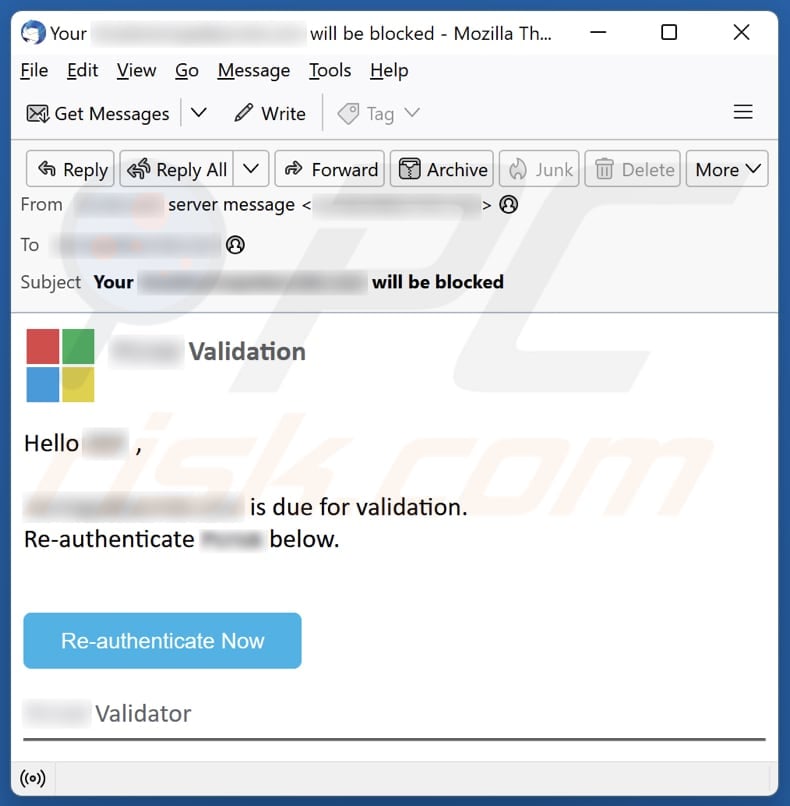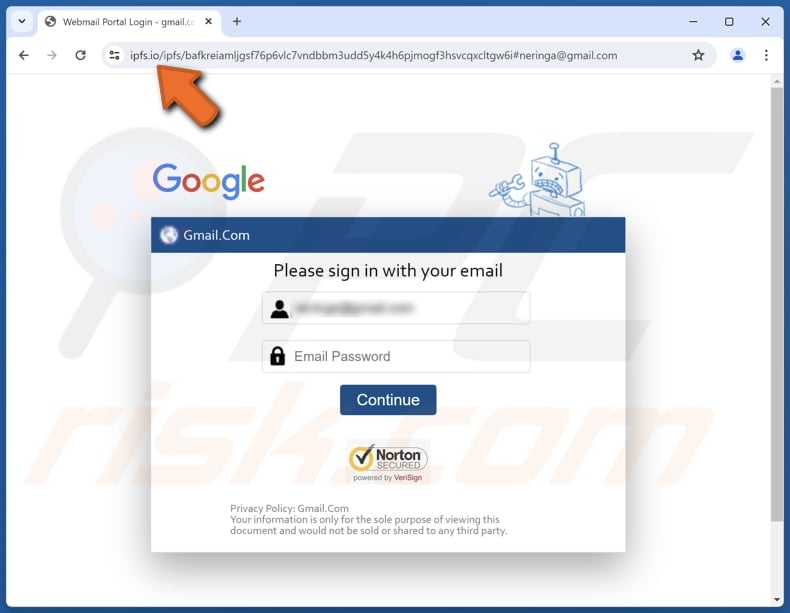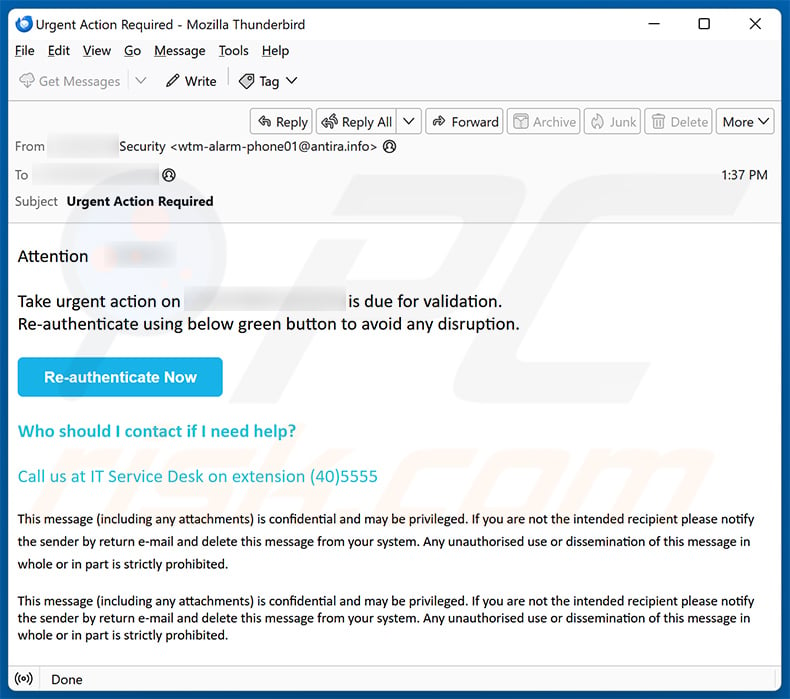How to identify fake emails like "Email Is Due For Validation"
Phishing/ScamAlso Known As: Email Is Due For Validation phishing scam
Get free scan and check if your device is infected.
Remove it nowTo use full-featured product, you have to purchase a license for Combo Cleaner. Seven days free trial available. Combo Cleaner is owned and operated by RCS LT, the parent company of PCRisk.com.
What kind of scam "Email Is Due For Validation"?
We have inspected the email and discovered that it is a fraudulent letter masquerading as a notification from an email service provider. The purpose of this scam email is to trick recipients into providing sensitive information to scammers. Emails of this type are classified as phishing emails. Recipients are strongly advised to ignore them.

More about the "Email Is Due For Validation" scam email
This scam email claims that the recipient's email account is at risk of being blocked or needs validation. It includes the Microsoft logo and provides a button labeled "Re-authenticate Now" to trick the recipient into clicking it and opening a phishing website. The page utilized in this scam is disguised as a legitimate Gmail sign-in website.
On this site, users are asked to sign in using their email account login credentials (email address and password). The entered information is sent to scammers, who can misuse it for malicious purposes. For instance, scammers can send phishing emails or malware to people in the victim's contacts.
Also, they can look for personal emails containing sensitive information (e.g., credit card details, ID card information, login credentials). Moreover, scammers can try to access other accounts (e.g., social media or banking accounts) using the same login credentials they have stolen.
Thus, falling victim to phishing emails like the one described in this article can have various negative consequences. For instance, recipients may become victims of identity theft, have their personal accounts and (or) money stolen, and encounter other problems. It is important to examine suspicious emails before providing any personal information or clicking links.
| Name | Email Is Due For Validation Scam |
| Threat Type | Phishing, Scam, Social Engineering, Fraud |
| Fake Claim | The recipient's email account is at risk of being blocked |
| Disguise | Letter from an email service provider |
| Symptoms | Unauthorized online purchases, changed online account passwords, identity theft, illegal access of the computer. |
| Distribution methods | Deceptive emails, rogue online pop-up ads, search engine poisoning techniques, misspelled domains. |
| Damage | Loss of sensitive private information, monetary loss, identity theft. |
| Malware Removal (Windows) |
To eliminate possible malware infections, scan your computer with legitimate antivirus software. Our security researchers recommend using Combo Cleaner. Download Combo CleanerTo use full-featured product, you have to purchase a license for Combo Cleaner. 7 days free trial available. Combo Cleaner is owned and operated by RCS LT, the parent company of PCRisk.com. |
Similar scam emails in general
Phishing emails are typically crafted to trick recipients into revealing sensitive information. Scammers behind such emails often impersonate legitimate organizations or entities to make their emails appear trustworthy. It is crucial for recipients to verify the legitimacy of emails before interacting with links, attachments, or requests for personal information to avoid falling victim to scams or malware.
Examples of phishing campaigns are "System Glitch", "DHL - Notice For Failed Package Delivery", and "WalletConnect Temporary Closure".
How do spam campaigns infect computers?
Users can infect computers through email by opening malicious attachments or links. File types attached to fraudulent emails can include MS Office and PDF documents, archives, executables, JavaScript files, and other types. Malware infiltrates computers when users execute it (e.g., open malicious executables or enable macros in malicious MS Office document files).
Links in emails can lead to malicious websites hosting malware. Users may unintentionally download malicious files or programs, or malicious sites may download malware automatically.
How to avoid installation of malware?
Be careful with irrelevant or unexpected emails from unknown senders. Do not open files or links in such emails. Always download software from official websites and app stores. Avoid using other sources, and never download pirated software, key generators, or cracking tools.
Additionally, avoid interacting with ads, pop-ups, buttons, or similar content encountered on shady websites. Keep your operating system and software up to date and utilize a reputable security tool for protection. If you have already opened malicious attachments, we recommend running a scan with Combo Cleaner Antivirus for Windows to automatically eliminate infiltrated malware.
Text presented in the "Email Is Due For Validation" email letter:
Subject: Your Email******** will be blocked
******** Validation
Hello ******** ,
******** is due for validation.
Re-authenticate ******** below.Re-authenticate Now
******** Validator
Screenshot of the phishing page used in this scam:

Another example of an email from "Email Is Due For Validation" spam campaign:

Text presented within:
Subject: Urgent Action Required
Attention ********,
Take urgent action on ******** is due for validation.
Re-authenticate using below green button to avoid any disruption.Re-authenticate Now
Who should I contact if I need help?
Call us at IT Service Desk on extension (40)5555
Screenshot of the promoted phishing site:

Instant automatic malware removal:
Manual threat removal might be a lengthy and complicated process that requires advanced IT skills. Combo Cleaner is a professional automatic malware removal tool that is recommended to get rid of malware. Download it by clicking the button below:
DOWNLOAD Combo CleanerBy downloading any software listed on this website you agree to our Privacy Policy and Terms of Use. To use full-featured product, you have to purchase a license for Combo Cleaner. 7 days free trial available. Combo Cleaner is owned and operated by RCS LT, the parent company of PCRisk.com.
Quick menu:
- What is Email Is Due For Validation phishing scam?
- Types of malicious emails.
- How to spot a malicious email?
- What to do if you fell for an email scam?
Types of malicious emails:
![]() Phishing Emails
Phishing Emails
Most commonly, cybercriminals use deceptive emails to trick Internet users into giving away their sensitive private information, for example, login information for various online services, email accounts, or online banking information.
Such attacks are called phishing. In a phishing attack, cybercriminals usually send an email message with some popular service logo (for example, Microsoft, DHL, Amazon, Netflix), create urgency (wrong shipping address, expired password, etc.), and place a link which they hope their potential victims will click on.
After clicking the link presented in such email message, victims are redirected to a fake website that looks identical or extremely similar to the original one. Victims are then asked to enter their password, credit card details, or some other information that gets stolen by cybercriminals.
![]() Emails with Malicious Attachments
Emails with Malicious Attachments
Another popular attack vector is email spam with malicious attachments that infect users' computers with malware. Malicious attachments usually carry trojans that are capable of stealing passwords, banking information, and other sensitive information.
In such attacks, cybercriminals' main goal is to trick their potential victims into opening an infected email attachment. To achieve this goal, email messages usually talk about recently received invoices, faxes, or voice messages.
If a potential victim falls for the lure and opens the attachment, their computers get infected, and cybercriminals can collect a lot of sensitive information.
While it's a more complicated method to steal personal information (spam filters and antivirus programs usually detect such attempts), if successful, cybercriminals can get a much wider array of data and can collect information for a long period of time.
![]() Sextortion Emails
Sextortion Emails
This is a type of phishing. In this case, users receive an email claiming that a cybercriminal could access the webcam of the potential victim and has a video recording of one's masturbation.
To get rid of the video, victims are asked to pay a ransom (usually using Bitcoin or another cryptocurrency). Nevertheless, all of these claims are false - users who receive such emails should ignore and delete them.
How to spot a malicious email?
While cyber criminals try to make their lure emails look trustworthy, here are some things that you should look for when trying to spot a phishing email:
- Check the sender's ("from") email address: Hover your mouse over the "from" address and check if it's legitimate. For example, if you received an email from Microsoft, be sure to check if the email address is @microsoft.com and not something suspicious like @m1crosoft.com, @microsfot.com, @account-security-noreply.com, etc.
- Check for generic greetings: If the greeting in the email is "Dear user", "Dear @youremail.com", "Dear valued customer", this should raise suspiciousness. Most commonly, companies call you by your name. Lack of this information could signal a phishing attempt.
- Check the links in the email: Hover your mouse over the link presented in the email, if the link that appears seems suspicious, don't click it. For example, if you received an email from Microsoft and the link in the email shows that it will go to firebasestorage.googleapis.com/v0... you shouldn't trust it. It's best not to click any links in the emails but to visit the company website that sent you the email in the first place.
- Don't blindly trust email attachments: Most commonly, legitimate companies will ask you to log in to their website and to view any documents there; if you received an email with an attachment, it's a good idea to scan it with an antivirus application. Infected email attachments are a common attack vector used by cybercriminals.
To minimise the risk of opening phishing and malicious emails we recommend using Combo Cleaner Antivirus for Windows.
Example of a spam email:

What to do if you fell for an email scam?
- If you clicked on a link in a phishing email and entered your password - be sure to change your password as soon as possible. Usually, cybercriminals collect stolen credentials and then sell them to other groups that use them for malicious purposes. If you change your password in a timely manner, there's a chance that criminals won't have enough time to do any damage.
- If you entered your credit card information - contact your bank as soon as possible and explain the situation. There's a good chance that you will need to cancel your compromised credit card and get a new one.
- If you see any signs of identity theft - you should immediately contact the Federal Trade Commission. This institution will collect information about your situation and create a personal recovery plan.
- If you opened a malicious attachment - your computer is probably infected, you should scan it with a reputable antivirus application. For this purpose, we recommend using Combo Cleaner Antivirus for Windows.
- Help other Internet users - report phishing emails to Anti-Phishing Working Group, FBI’s Internet Crime Complaint Center, National Fraud Information Center and U.S. Department of Justice.
Frequently Asked Questions (FAQ)
Why did I receive this email?
These emails are typically distributed to numerous recipients. They are generic scams and not personalized for individual recipients.
I have provided my personal information when tricked by this email, what should I do?
If your email account login credentials have been stolen by scammers, immediately change the password for the compromised account. Also, update passwords for any other accounts that use the same or similar password.
I have downloaded and opened a malicious file attached to an email, is my computer infected?
Executable files such as .exe can infect computers upon opening. However, opening documents like PDFs or MS Office files typically does not lead to malware infiltrating the operating system. Whether your computer has been infected depends on the file type and actions taken.
I have read the email but did not open the attachment, is my computer infected?
Emails alone cannot infect systems. However, clicking on links or opening files in deceptive emails can result in malware infiltration.
Will Combo Cleaner remove malware infections that were present in email attachment?
Combo Cleaner has the capability to identify and remove nearly all known malware infections. Due to the tendency of sophisticated malware to conceal itself deeply within the system, a thorough full system scan is required for complete removal.
Share:

Tomas Meskauskas
Expert security researcher, professional malware analyst
I am passionate about computer security and technology. I have an experience of over 10 years working in various companies related to computer technical issue solving and Internet security. I have been working as an author and editor for pcrisk.com since 2010. Follow me on Twitter and LinkedIn to stay informed about the latest online security threats.
PCrisk security portal is brought by a company RCS LT.
Joined forces of security researchers help educate computer users about the latest online security threats. More information about the company RCS LT.
Our malware removal guides are free. However, if you want to support us you can send us a donation.
DonatePCrisk security portal is brought by a company RCS LT.
Joined forces of security researchers help educate computer users about the latest online security threats. More information about the company RCS LT.
Our malware removal guides are free. However, if you want to support us you can send us a donation.
Donate
▼ Show Discussion